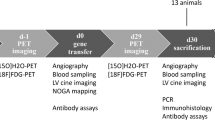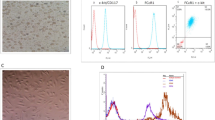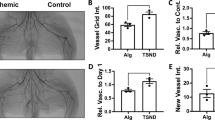Abstract
Adenovirus-mediated ex vivo gene transfer of basic fibroblast growth factor (bFGF), a new strategy for the treatment of chronic vascular occlusive disease, was examined in a rabbit model of hind limb ischemia. The left femoral artery was completely excised to induce an ischemic state in the hind limb of male rabbits. Simultaneously, a skin section was resected from the wound, and host fibroblasts were cultured. The cultured fibroblasts were infected with adenovirus vector containing modified human bFGF cDNA with the secretory signal sequence (AxCAMAssbFGF) or LacZ cDNA (AxCALacZ). At 21 days after femoral artery excision, the gene-transduced fibroblasts were administered through the left internal iliac artery. The fibroblasts significantly accumulated in the ischemic hind limb, and the AxCAMAssbFGF-treated cells secreted bFGF for less than 14 days without elevation of systemic bFGF level. At 28 days after cell administration, calf blood pressure ratio, angiographic score, capillary density of muscle tissue and blood flow of the left internal iliac artery were determined, and animals with AxCAMAssbFGF-treated cells showed significantly greater development of collateral vessels, as compared with those with AxCALacZ-treated cells. These findings suggest that adenovirus-mediated ex vivo gene transfer of bFGF was effective for improvement of chronic limb ischemia.
This is a preview of subscription content, access via your institution
Access options
Subscribe to this journal
Receive 12 print issues and online access
$259.00 per year
only $21.58 per issue
Buy this article
- Purchase on Springer Link
- Instant access to full article PDF
Prices may be subject to local taxes which are calculated during checkout









Similar content being viewed by others
References
Sasayama S, Fujita M . Recent insight into coronary collateral circulation Circulation 1992 85: 1197–1204
Carmeliet P . Mechanisms of angiogenesis and arteriogenesis Nat Med 2000 6: 389–395
Hockel M et al. Therapeutic angiogenesis Arch Surg 1993 128: 423–429
Takeshita S et al. Therapeutic angiogenesis. A single intra-arterial bolus of vascular endothelial growth factor augments revascularization in a rabbit ischemic hind limb model J Clin Invest 1994 93: 662–670
Unger EF et al. Basic fibroblast growth factor enhances myocardial collateral flow in a canine model Am J Physiol 1994 266: H1588–H1595
Feldman LJ et al. Low-efficacy of percutaneous adenovirus-mediated arterial gene transfer in the atherosclerotic rabbit J Clin Invest 1995 95: 2662–2671
Tsurumi Y et al. Direct intramuscular gene transfer of naked DNA encoding vascular endothelial growth factor augments collateral development and tissue perfusion Circulation 1996 94: 3281–3290
Bauters C et al. Physiological assessment of augmented vascularity induced by VEGF in ischemic rabbit hindlimb Am J Physiol 1994 267: H1263–H1271
Abraham JA et al. Nucleotide sequence of a bovine clone encoding the angiogenic protein, basic fibroblast growth factor Science 1986 233: 545–548
Sasada R, Seno M, Watanabe T, Igarashi K . Expression of modified bFGF cDNAs in mammalian cells Ann NY Acad Sci 1991 638: 149–160
Kass-Eisler A et al. Quantitative determination of adenovirus-mediated gene delivery to rat cardiac myocytes in vitro and in vivo Proc Natl Acad Sci USA 1993 90: 11498–11502
Arras M et al. The delivery of angiogenic factors to the heart by microsphere therapy Nat Biotechnol 1998 16: 159–162
Friesel RE, Maciag T . Molecular mechanisms of angiogenesis: fibroblast growth factor signal transduction FASEB J 1995 9: 919–925
Losordo DW et al. Gene therapy for myocardial angiogenesis: initial clinical results with direct myocardial injection of phVFGF165 as sole therapy for myocardial ischemia Circulation 1998 98: 2800–2804
Wilson JM . Adenoviruses as gene-delivery vehicles New Engl J Med 1996 334: 1185–1187
Yang Y et al. Cellular immunity to viral antigens limits E1-deleted adenoviruses for gene therapy Proc Natl Acad Sci USA 1994 91: 4407–4411
Baumgartner I et al. Constitutive expression of phVEGF165 after intramuscular gene transfer promotes collateral vessel development in patients with critical limb ischemia Circulation 1998 97: 1114–1123
Risau W . What, if anything, is an angiogenic factor? Cancer Metast Rev 1996 15: 149–151
Ozaki H et al. Basic fibroblast growth factor is neither necessary nor sufficient for the development of retinal neovascularization Am J Pathol 1998 153: 757–765
Gowdak LHW et al. Adenovirus-mediated VEGF121 gene transfer stimulates angiogenesis in normoperfused skeletal muscle and preserves tissue perfusion after induction of ischemia Circulation 2000 102: 565–571
Wu HM, Yuan Y, McCarthy M, Granger HJ . Acidic and basic FGFs dilate arterioles of skeletal muscle through a NO-dependent mechanism Am J Physiol 1996 271: H1087–H1094
Miyake S et al. Effective generation of recombinant adenoviruses using adenovirus DNA–terminal protein complex and a cosmid bearing the full-length virus genome Proc Natl Acad Sci USA 1996 93: 1320–1324
Akimoto M et al. Adenovirally expressed basic fibroblast growth factor rescues photoreceptor cells in RCS rats Invest Ophthalmol Vis Sci 1999 40: 273–279
Kurokawa T, Sasada R, Iwane M, Igarashi K . Cloning and expression of cDNA encoding human basic fibroblast growth factor FEBS 1987 213: 189–194
Takahashi JC et al. Adenovirus-mediated gene transfer of basic fibroblast growth factor induces in vitro angiogenesis Atherosclerosis 1997 132: 199–205
Koyama H, Reidy MA . Reinjury of arterial lesions induces intimal smooth muscle cell replication that is not controlled by fibroblast growth factor 2 Circ Res 1997 80: 408–417
Pu LQ et al. A persistent hind limb ischemia model in the rabbit J Invest Surg 1994 7: 49–60
Kardami E, Fandrich RR . Basic fibroblast growth factor in atria and ventricles of the vertebrate heart J Cell Biol 1989 109: 1865–1875
Acknowledgements
This study was supported by a Grant-in Aid for Scientific Research (C) from the Ministry of Education, Science, and Culture of Japan (10671103). The studies using 111In and 51Cr were carried out at Radioisotope Center, The University of Tokyo.
Author information
Authors and Affiliations
Rights and permissions
About this article
Cite this article
Ohara, N., Koyama, H., Miyata, T. et al. Adenovirus-mediated ex vivo gene transfer of basic fibroblast growth factor promotes collateral development in a rabbit model of hind limb ischemia. Gene Ther 8, 837–845 (2001). https://doi.org/10.1038/sj.gt.3301475
Received:
Accepted:
Published:
Issue Date:
DOI: https://doi.org/10.1038/sj.gt.3301475
Keywords
This article is cited by
-
Transmembrane stem factor nanodiscs enhanced revascularization in a hind limb ischemia model in diabetic, hyperlipidemic rabbits
Scientific Reports (2024)
-
Diabetes-associated macrovascular complications: cell-based therapy a new tool?
Endocrine (2013)
-
Effect of bone marrow mesenchymal stem cells transfected with rAAV2-bFGF on early angiogenesis of calvarial defects in rats
Journal of Huazhong University of Science and Technology [Medical Sciences] (2010)
-
Cardiovascular gene therapy: current status and therapeutic potential
British Journal of Pharmacology (2007)
-
Die chronische kritische Unterschenkelischämie: prätherapeutische Diagnostik, Methoden der Revaskularisation
Der Radiologe (2006)



